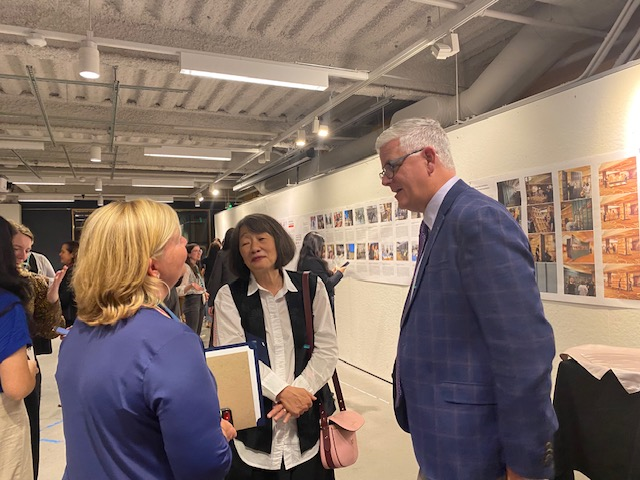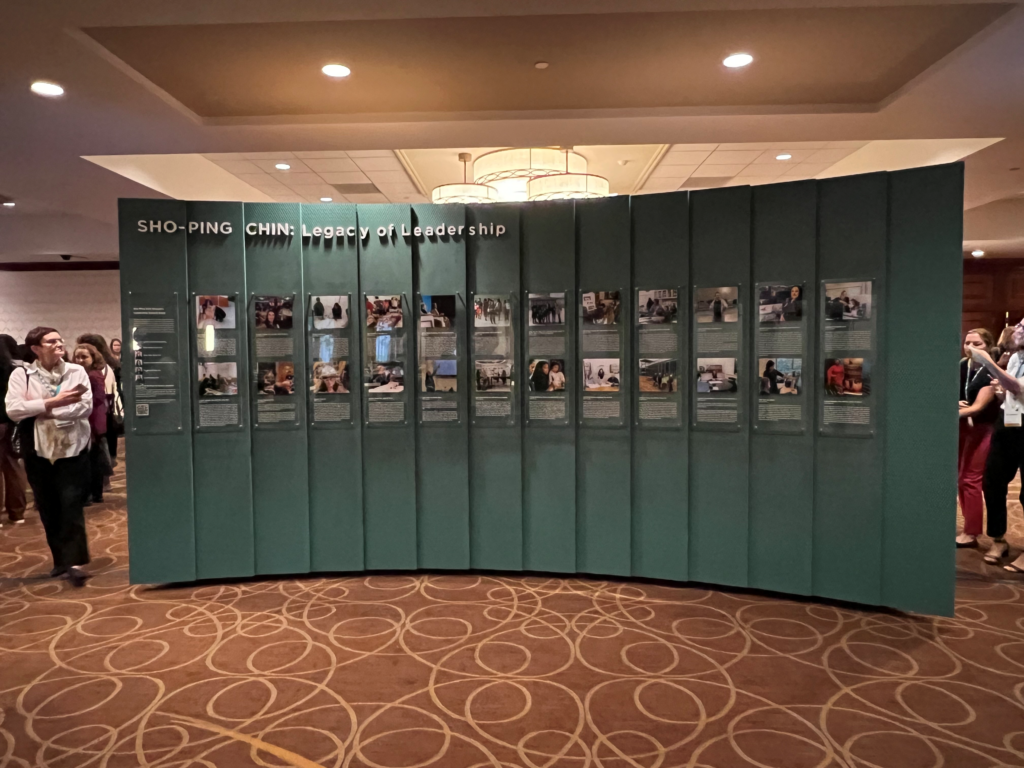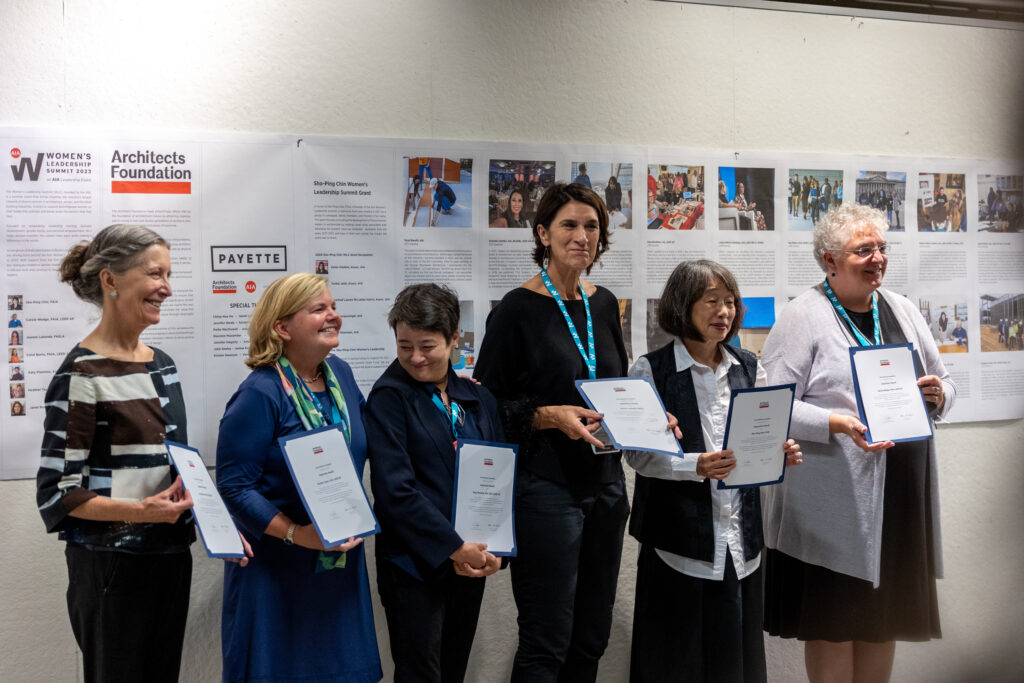Architects Foundation
Architects Foundation Honors WLS Grant Founders at Boston Summit
At this year’s AIA Women’s Leadership Summit (WLS), AIA and the Architects Foundation were honored to join Payette for a celebratory happy hour at their Boston office to honor the donors and recipients of the Sho-Ping Chin WLS Grant. Established in 2017, the grant is named in memory of Sho-Ping Chin, FAIA, a principal at Payette and one of the founders of the Women’s Leadership Summit. The grant covers the travel and registration costs to attend the summit, enabling a greater number of women architects to experience the community, knowledge-sharing, and leadership training that the Summit offers.
This year’s grant recipients, Laura Sherman of Decatur, GA; Libertad Lauren McLellan Harris of Beverly, NJ; Seher Hashmi of Orlando, FL; Mika Naraynsingh of Washington, DC; and Tooba Jalal of New York, NY; were joined at the reception by many past recipients. Also joining the happy hour were several Summit attendees who received funding from their local AIA chapters to attend the Summit, a testament to the impactful vision and generosity of Sho-Ping Chin, the WLS founders, and the donors who initiated the inaugural WLS grant in 2017.

Payette President Kevin B. Sullivan, FAIA, chats with Annping Chin, sister of Sho-Ping Chin, and Heather Taylor, AIA, a founding donor of the WLS SPC Grant.
A spectacular exhibition produced by Payette shared the life and legacy of Sho-Ping Chin and celebrated the success of the Women’s Leadership Summit and the community of women architect leaders it has inspired and cultivated.

Payette exhibition honoring the life and legacy of Sho-Ping Chin.
The Architects Foundation was honored to recognize some of those visionary donors at the happy hour, with Executive Director Marci Reed and board president Bill Roschen, FAIA, presenting the Architects Foundation’s inaugural Inspiration Award to Carol Burns, FAIA; Heather Taylor, AIA; Janet Ross, AIA; Katy Flammia, AIA; Jeanne Lukenda, FASLA; and Carole Wedge, FAIA.

AF Inspiration Award recipients.
Looking ahead to next year’s Summit, the Architects Foundation is seeking donations to enable another cohort of future women architect leaders to attend. Support women in architecture by donating today.
SAY IT LOUD exhibit launches at The Octagon!
WASHINGTON – The Architects Foundation today announced the launch of its latest exhibit at The Octagon. SAY IT LOUD, curated by Pascale Sablan, FAIA, will be on view through December 2022.
SAY IT LOUD is an exhibit featuring projects by women and diverse design professionals, as well as interviews about their experiences in the architecture and design professions. This exhibit shares, protects and celebrates the journey of the underrepresented to inspire the next generation. SAY IT LOUD at The Octagon in Washington, DC, will include a special component featuring Black architects from The American Institute of Architects’ College of Fellows.
SAY IT LOUD is curated by Pascale Sablan, FAIA, the 2021 AIA Whitney Young Award recipient. SAY IT LOUD is sponsored by the National Organization of Minority Architects (NOMA), the AIA College of Fellows, and the Architects Foundation.
The Octagon is open Thursday-Saturday from 11am-4pm. Museum admission is $10/adult, $5/children and teens under 18, and free for children under 5.
Free guided tours will be offered at 11am and 3pm (roughly 45 mins) and are included with museum admission. Self-guided tour information is available on-site.
For more information, please visit https://architectsfoundation.org/our-programs/.
The Octagon to host digital exhibition on public art with CODAworx
WASHINGTON– The Octagon, the museum of the Architects Foundation, today announced the launch of a digital exhibition for CODAWorx’s 2020 awardees.
Through September, visitors will be able to explore award-winning projects celebrating excellence in the field of commissioned art.
The internationally acclaimed CODAawards celebrate the projects that most successfully integrate commissioned art into interior, architectural, or public spaces. The CODAawards program honors the individuals and the teams whose collective imaginations create the public and private spaces that inspire us every day.
The Octagon will also be hosting virtual lectures throughout the summer about award-winning projects that focus on diversity, social justice, and community engagement.
“CODAworx’s awardees elevate art and architecture by raising awareness about environmental and social issues, demonstrating the importance of innovation and creativity, contributing to healing and hospitality environments, and developing community engagement and pride,” said Marci Reed, Architects Foundation Executive Director.
“We are delighted bring the CODAawards exhibit into the digital arena while The Octagon remains closed to the public.”
View the exhibit >
ABOUT CODAworx
CODAworx provides a platform to celebrate design projects featuring commissioned artwork in interior, architectural, and public spaces. The CODAworx team is on a mission to transform every space in the world by making more great commissions happen. Since 2012, the site has been the online “Hub of the Commissioned Art Economy,” where anyone can showcase work, hire artists, and get hired. Visit www.codaworx.com.
Society’s Cage Installation Opens on the National Mall
Washington, DC – Today the Society’s Cage interpretive installation opens to the public on the National Mall in Washington, DC. SmithGroup, one of the nation’s leading integrated design firms, is the lead sponsor for the project, initiated by a diverse team of designers in their Washington, DC office. The installation’s opening is timed to coincide with the March on Washington, organized by the National Action Network, happening today.
“We were inspired to create the installation following the murders of George Floyd and Breonna Taylor,” explains Dayton Schroeter, lead designer and a principal at SmithGroup. “The pavilion is a real and raw reflection of the conversations about racism happening now. It’s a physical manifestation of the institutional structures that have undermined the progress of Black Americans over the history of this country.”
The designers intend for the installation to place the recent victims killed by police in the context of the 400+ year continuum of racialized state violence in the United States. Weathered steel bars hanging from a steel plate ceiling form a perfect cube atop a raised 15-foot square platform, encircled with educational content around its base. Historical data for four primary institutional forces of racism are expressed on the cube’s perimeter and triangulated within the interior, carving a void into which visitors can enter. Within this void the visitor experiences clashing senses, feeling both the figurative weight of oppression from the bars around and above them, while also being enveloped in an open-air sanctuary for reflection.
“The name Society’s Cage refers to the societal constraints that limit the prosperity of the Black community,” says Julian Arrington, who led the design with Schroeter, and is an architectural designer at SmithGroup. “The pavilion creates an experience to help visitors understand and acknowledge these impacts of racism and be moved to create change.”
Visitors are encouraged to participate in a shared experience upon entering the pavilion. After holding their breath for as long as they can, evoking the common plea among victims of police killings, “I can’t breathe,” visitors then post a video reflection of their experience on social media using the hashtag #SocietysCage. This exercise is meant not only to build empathy but expand the installation’s impact online to allow anyone to participate in this shared exercise.
The pavilion was fabricated by Gronning Design + Manufacturing LLC in Washington, DC, and Mejia Ironworks in Hyattsville, Maryland. A soundscape was commissioned from a pair of composers, Raney Antoine, Jr. and Lovell “U-P” Cooper. Comprised of four pieces, each 8 minutes and 46 seconds in length in recognition of the time George Floyd suffered under the knee of police, they are themed to reflect each of the four institutional forces that sculpted the pavilion’s interior (mass incarceration, police terrorism, capital punishment and racist lynchings).
SmithGroup has partnered with the Architects Foundation to raise funds for their Diversity Advancement scholarship program through the installation.
“The tragedies of George Floyd and many others have cemented clearly upon us that centuries of systemic racism and structural inequality cannot be ‘unseen’ anymore,” said James Walbridge, AIA, Foundation President. “We are all on a new journey together, with compassion and empathy as our shepherds, to make real societal change. Society’s Cage is a timely partnership for us.”
Corporate sponsors include Advanced Thermal Solutions, LLC; Bonstra|Haresign Architects; D|Watts Construction, LLC; Herrero Builders; Kohler; and The Center for Racial Equity and Justice. In-kind donors include Silman and Alan Karchmer Photography. Over 150 individuals have also contributed financial support to the project. Donations continue to be accepted through the Architects Foundation’s portal.
The pavilion will remain on display until September 12, 2020, and then is intended to be exhibited in a new location in the Washington metro region, and eventually tour to other cities across the country.
The Architects Foundation (www.architectsfoundation.org) leads philanthropic efforts to attract, inspire, and invest in a next-generation design community through scholarships and exhibitions. The Architects Foundation owns the historic Octagon building in the nation’s capital, activating the space to demonstrate the value architects and architecture bring to culture.
SmithGroup (www.smithgroup.com) is one of the world’s preeminent integrated design firms. Working across a network of 15 offices in the U.S. and China, a team of 1,300 experts is committed to excellence in strategy, design, and delivery. The scale of the firm’s thinking and organization produces partnerships with forward-looking clients that maximize opportunities, minimize risk and solve their most complex problems. SmithGroup creates exceptional design solutions for healthcare, science and technology organizations, higher education and cultural institutions, urban environments, diverse workplaces, mixed-use and waterfront developments, and parks and open spaces.
The Unbuilt Crosby Arboretum and the Legacy of E. Fay Jones
This virtual discussion explores the work by Hans Herrmann, AIA and students to create physical and virtual reality models of four unrealized E. Fay Jones buildings at the Crosby Arboretum, buildings intended to accompany the iconic Pinecote Pavilion completed in 1985.
The Unbuilt Crosby Arboretum is the only known E. Fay Jones multi-building composition/campus. Robert Ivy, FAIA, AIA CEO and biographer on E. Fay Jones highlights how Jones’ work is deeply rooted to place and nature. Jones received the AIA Gold Medal in 1990, the Institute’s highest honor.
Watch the panel >
Panelists:
Hans C. Herrmann, AIA, LEED Green Assoc., NCARB, Associate Professor of Architecture at Mississippi State University
Robert A. Ivy, FAIA, Executive Vice President and Chief Executive Officer of the American Institute of Architects (AIA)
Moderator:
George Smart, founder of USModernist.org and host of USModernist Radio
Panel Recap: Placemaking at HBCUs
Historically Black Colleges and Universities (HBCUs) make up 3 percent of the country’s colleges and universities, enroll 10 percent of all African American students, and produce almost 20 percent of all African American graduates, making these institutions increasingly impactful and vital. While meeting admissions goals and improving retention rates are critical goals for any college, for HBCUs history, students’ backgrounds, cultural nuances, and other factors require different approaches to student success. Thoughtful campus planning and design can play an important role in creating environments that allow students to embark upon higher education as the cornerstone of the Dream.
On January 30, we convened a panel at The Octagon to discuss placemaking at HBCUs with:
Andrew B. Feiler, Photographer
Bradford C. Grant, Professor of Architecture, Howard University
Warren L. Williams, AIA, Principal, Lord Aeck Sargent
Renée Yancey, Managing Director of EDI Development & Workforce Strategy, The American Institute of Architects
Watch the recap >
Read our statement on The Octagon >


